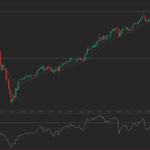 Yesterday’s trade saw NZD/USD within the range of 0.6610-0.6664. The pair closed at 0.6639, shedding 0.08% on a daily basis, while extending the loss from Monday. The daily low has been the lowest level since December 3rd, when a low of 0.6605 was registered.
Yesterday’s trade saw NZD/USD within the range of 0.6610-0.6664. The pair closed at 0.6639, shedding 0.08% on a daily basis, while extending the loss from Monday. The daily low has been the lowest level since December 3rd, when a low of 0.6605 was registered.
According to Binary Tribunes analysis on historical volatility, the average intraday volatility for the pair was 1.217% in November, or the lowest since December 2014, when average volatility was estimated at 1.181%. At the same time, the average daily volatility for NZD/USD was 1.093% in November, or the lowest one since January 2015. Back then the average daily volatility was estimated at 1.076%.
At 8:07 GMT today NZD/USD was down 0.04% for the day to trade at 0.6643. The pair touched a daily low at 0.6623 at 3:10 GMT, making an exact test of the range support level (S3). Short-term support may be received at the low from Monday (0.6610), after that at the 23.60% Fibonacci level (0.6586), which reflects the descent from April 29th high to September 23rd low, and finally at the low from November 30th (0.6513). December 8th high (0.6664) may act as an immediate resistance.
Today NZD/USD trading may be influenced by one key event listed below.
Fundamentals
New Zealand
RBNZ policy decision
The Reserve Bank of New Zealand (RBNZ) will probably cut its benchmark interest rate (the official cash rate) by 25 basis points (0.25 percentage points) to 2.50% at the policy meeting today, according to market expectations. If so, it would be the fourth rate reduction during the current year. In October the central bank left the benchmark intact at 2.75%, but indicated that future rate cuts seem likely in dependence on the flow of economic data.
According to extracts from the statement, taken by RBNZ Governor, Graeme Wheeler, following the banks most recent policy decision: ”The sharp fall in dairy prices since early 2014 continues to weigh on domestic farm incomes. However, growth in the services sector and construction remains robust, driven by net immigration, tourism, and low interest rates. Global dairy prices have risen in recent weeks, contributing to improved household and business sentiment. However, it is too early to say whether these recent improvements will be sustained.”
”CPI inflation remains below the 1 to 3 percent target range, largely reflecting a combination of earlier strength in the New Zealand dollar and the 60 percent fall in world oil prices since mid-2014.”
”Annual CPI inflation is expected to return well within the target range by early 2016, as the effects of earlier petrol price falls drop out of the CPI calculation and in response to the fall in the exchange rate since April. However, the exchange rate has been moving higher since September, which could, if sustained, dampen tradables sector activity and medium-term inflation. This would require a lower interest rate path than would otherwise be the case.”
”To ensure that future average CPI inflation settles near the middle of the target range, some further reduction in the OCR seems likely. This will continue to depend on the emerging flow of economic data. It is appropriate at present to watch and wait.”
Short-term interest rates are of utmost importance for the valuation of national currencies. In case the Reserve Bank of New Zealand is dovish about inflationary pressure and overall economic activity and, thus, decides to reduce its benchmark rate, this will have a strong bearish effect on the kiwi dollar.
The official decision on policy and the press conference are scheduled at 20:00 GMT.
Bond Yield Spread
The yield on New Zealand’s 2-year government bonds went as high as 2.580% on December 8th, after which it slid to 2.575% at the close to lose 2.5 basis points (0.025 percentage point) compared to December 7th. It has been the ninth drop in the past twelve trading days and also a second consecutive one.
The yield on US 2-year government bonds climbed as high as 0.947% on December 8th, after which it closed at 0.935% to remain unchanged compared to December 7th.
The spread between 2-year New Zealand and 2-year US bond yields, which reflects the flow of funds in a short term, narrowed to 1.640% on December 8th from 1.665% on December 7th. The December 8th yield spread has been the lowest one since December 3rd, when the difference was 1.616%.
Meanwhile, the yield on New Zealand’s 10-year government bonds soared as high as 3.565% on December 8th, after which it closed at the exact same level to lose 2 basis points (0.02 percentage point) compared to December 7th. It has been the eighth drop in the past twelve trading days and also a second consecutive one.
The yield on US 10-year government bonds climbed as high as 2.245% on December 8th, after which it slipped to 2.227% at the close to lose 0.009 percentage point compared to December 7th. It has been the 12th drop in the past seventeen trading days and also a third consecutive one.
The spread between 10-year New Zealand and 10-year US bond yields narrowed to 1.338% on December 8th from 1.349% on December 7th. The December 8th yield difference has been the lowest one since December 4th, when the spread was 1.312%.
Daily and Weekly Pivot Levels
By employing the Camarilla calculation method, the daily pivot levels for NZD/USD are presented as follows:
R1 – 0.6644
R2 – 0.6649
R3 (range resistance) – 0.6655
R4 (range breakout) – 0.6669
S1 – 0.6634
S2 – 0.6629
S3 (range support) – 0.6623
S4 (range breakout) – 0.6609
By using the traditional method of calculation, the weekly pivot levels for NZD/USD are presented as follows:
Central Pivot Point – 0.6684
R1 – 0.6854
R2 – 0.6961
R3 – 0.7131
S1 – 0.6577
S2 – 0.6407
S3 – 0.6300





